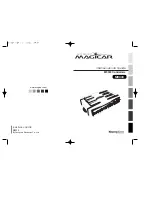
Light sources of extreme intensity such as sunlight and hal-
ogen lamps, if directed at the receiver, can cause a dramatic
signal change resulting in fault and alarm signals. To prevent
this problem direct sunlight into the transmitter/receiver
unit should be avoided. There should be a minimum of 10°
between the pathway of the light source and detector and
the line of sight between detector and reflector.
Operation of the detector through panes of glass should
be avoided. Since single ended beam detectors operate on
a reflection principle, a pane of glass perpendicular to the
line of sight between the detector and the reflector can
reflect the light beam from the transmitter to the receiver.
If this occurs, the detector will not be able to distinguish
these reflections from those of the reflector and the pro-
tected space will be compromised.
Panes of glass will also absorb some of the light as it passes
through it. This absorption of light will reduce the acceptable
installed distance between the detector and the reflector.
In cases where operation through panes of glass cannot be
avoided some specific installation practices can help to mini-
mize the effects of the glass. These practices include: avoid
penetration of multiple panes of glass, position the glass so
that it is not perpendicular to the line of sight between the
detector and the reflector, (A minimum of 10° off perpen-
dicular should be considered), and make certain that the
glass is smooth, clear and mounted securely. The complete
reflector blockage test can be used to determine if the instal-
lation is acceptable. See Testing and Maintenance Section of
this manual.
Where high ceilings (in excess of 30 feet or 9.1 meters) are
present additional beams may be required to detect smoke at
lower levels. See System Sensor’s Projected Beam Detector
Applications Guide for futher explanation.
Wiring Installation Guidelines
Always install all wiring in compliance with the Canadian Electrical
Code, and/or the applicable local codes, and any special require-
ments of the local authority having jurisdiction. Proper wire gauges
and suitable means for strain relief should be used. The conduc-
tors used to connect beam smoke detectors to control panels and
accessory devices should be color-coded to reduce the likelihood
of wiring errors. Improper connections can prevent a system from
responding properly in the event of a fire.
Installation wire used for the beam detector shall be no smaller
than 22 AWG (1.0 mm
2
). For best system performance, all wir-
ing should be twisted pair and installed in separate grounded
conduit. Do NOT mix fire system wiring in the same conduit
as any other electrical wiring. Shielded cable may be used to
provide additional protection against electrical interference.
When installing the beam smoke detector in applications where
the head unit will be mounted to either a wall or the ceiling
using the multi-mount kit (BEAMMMK) flexible conduit will be
used. The surface mount kit (BEAMSMK) and multi-mount kit
(BEAMMMK) must be installed with the cable before wring the
unit, according to the instructions supplied with the kit.
When the detector has been mounted over a recessed junction
box, all wiring should be routed out of the box and behind
the detector to the bottom of the detector where the terminal
blocks are located. When installing the wiring in the junction
box be sure to leave enough wire in the box to connect to the
terminal blocks. (Approximately 9″ [23cm) of wire outside of
the junction box will be required for proper installation). All
wiring to the detector is done via pluggable terminal blocks.
In order to properly make electrical connections strip approxi-
mately
1
/
4
″ (6mm) of insulation from the end of the wire, slid-
ing the bare end of the wire under the clamping plate screw.
Figure 6 shows all the wiring connections to the transmitter/receiver
unit. Figure 7 shows the proper wiring diagram for either class A or
class B operation. Figure 8 shows the connections that are neces-
sary when using one of the optional remote test stations (RTS451
or RTS451KEYA). Figure 9 shows the remote outputs for trouble
and alarm.
Figure 6. Wiring Connections at Detector
POWER OUT (
–)
POWER OUT (+)
POWER IN (
–)
POWER IN (+)
RESET I NPUT
TEST INPUT
AUX (
–)
REMOTE ALARM OUT
Not used
REMOTE TROUBLE OUT
TROUBLE COM
TROUBLE N.C.
ALARM COM
ALARM N.O.
ALARM COM
ALARM N.O.
T3
T2
T1
T4
C0271-00
D400-73-00
6
I56-2541-00R




































